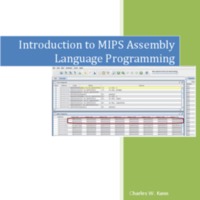Introduction To MIPS Assembly Language
Programming
Dublin Core
Description
This book was written to introduce students to assembly language programming in MIPS. As with all assembly
language programming texts, it covers basic operators and instructions, subprogram calling, loading and
storing memory, program control, and the conversion of the assembly language program into machine code.
However this book was not written simply as a book on assembly language programming. The larger purpose
of this text is to show how concepts in Higher Level Languages (HLL), such as Java or C/C++, are
represented in assembly. By showing how program constructs from these HLL map into assembly, the
concepts will be easier to understand and use when the programmer implements programs in languages like
Java or C/C++. Concepts such as references and variables, registers, binary and Boolean operations,
subprogram execution, memory types (heap, stack, and static), and array processing are covered to clarify the decisions made when implementing HLL. Program control is presented using a mapping from structured programs in pseudo code to help students understand structured programming, and why it exists. Memory
access in assembly is presented to high light the difference between references (pointers) and values, and how these impact HLL.
language programming texts, it covers basic operators and instructions, subprogram calling, loading and
storing memory, program control, and the conversion of the assembly language program into machine code.
However this book was not written simply as a book on assembly language programming. The larger purpose
of this text is to show how concepts in Higher Level Languages (HLL), such as Java or C/C++, are
represented in assembly. By showing how program constructs from these HLL map into assembly, the
concepts will be easier to understand and use when the programmer implements programs in languages like
Java or C/C++. Concepts such as references and variables, registers, binary and Boolean operations,
subprogram execution, memory types (heap, stack, and static), and array processing are covered to clarify the decisions made when implementing HLL. Program control is presented using a mapping from structured programs in pseudo code to help students understand structured programming, and why it exists. Memory
access in assembly is presented to high light the difference between references (pointers) and values, and how these impact HLL.
Creator
Source
https://cupola.gettysburg.edu/cgi/viewcontent.cgi?article=1001&context=oer
Publisher
Date
2015
Contributor
Baihaqi
Rights
Creative Commons
Format
PDF
Language
English
Type
Files
Collection
Citation
Charles W. Kann, “Introduction To MIPS Assembly Language
Programming,” Open Educational Resources (OER) , accessed December 10, 2025, https://oer.uinsyahada.ac.id/items/show/2719.


